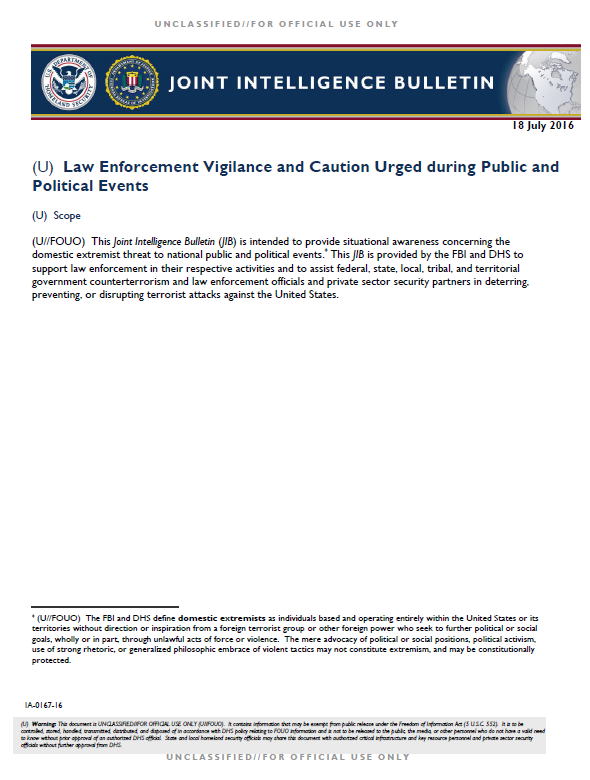(U//FOUO) This Joint Intelligence Bulletin (JIB) is intended to provide situational awareness concerning the domestic extremist threat to national public and political events. This JIB is provided by the FBI and DHS to support law enforcement in their respective activities and to assist federal, state, local, tribal, and territorial government counterterrorism and law enforcement officials and private sector security partners in deterring, preventing, or disrupting terrorist attacks against the United States.
(U) Domestic Extremists Pose Persistent Threat to Public and Political Events
(U//FOUO) The FBI and DHS assess the domestic extremist threat to public and political events will persist due to the ongoing nature of many of the drivers of extremist violence, including the upcoming presidential national conventions, racial tensions, and the perceived abuse of power by government authorities. Some domestic extremist movements have previously exploited First Amendment protected activities such as public or political gatherings—without the knowledge or support of the organizers of these events—in order to facilitate or commit violent acts. A recent example of this exploitation occurred at a 26 June 2016 white supremacist rally that resulted in violence in Sacramento, California. The presidential national conventions could present such an opportunity for exploitation. The FBI and DHS urge law enforcement officers to be vigilant and cautious during all public and political events, as these situations could be used to mask or promote violent extremist activity.
(U) The following are examples of domestic extremist movements that have exploited public and political events to commit or incite violence and other criminal acts.
» (U//FOUO) Black separatist extremists (BSEs) have targeted law enforcement for violence in response to the historical mistreatment of African Americans and their perception of an unjust judicial system. The FBI and DHS judge on the basis of threat reporting and previous BSE responses to police-involved incidents and outcomes of legal proceedings that perceived police brutality targeting African Americans will likely continue to serve as a catalyst for retaliatory violence by BSEs. BSEs have been known to attempt to incite violence at large crowds against perceived enemies such as law enforcement. Traditionally, they aim to recruit young people and individuals with the propensity for violence, which have also included gang members.
» (U//FOUO) White supremacist extremists (WSEs) and their ideological opponents—including some anarchist extremists—have violently clashed at First Amendment protected events. WSEs have historically targeted for violence racial, ethnic, and religious minorities, the federal government, and those perceived to detract from the purity of the white race– to include sex offenders, drug abusers, the homeless, and “race traitors” (i.e. whites perceived as disloyal to their race). WSEs can be motivated by religious or political beliefs.
» (U//FOUO) Militia extremists use force or violence against those whom they perceive as infringing upon their Constitutional rights, including law enforcement officers. Militia extremists may possess and use firearms, demonstrate a familiarity with explosive devices, conduct paramilitary training, and engage in operational security to avoid law enforcement detection or scrutiny in an effort to advance their ideological objectives. Since the April 2014 armed standoff in Bunkerville, Nevada, militia extremists have demonstrated an increasingly aggressive posture to engage law enforcement in armed conflict. Militia extremists have also shown the intent to serve as security or peacekeepers at rallies and protests—which may incite violence from their ideological opponents.
» (U//FOUO) Anarchist extremists have committed violence against law enforcement officers as perceived symbols of authority and oppression. Some anarchist extremists are also ideologically opposed to racism and may be motivated to commit violence against law enforcement in response to actions they view as racially-motivated. Anarchist extremists in the past have exploited lawful protected events to conduct criminal activity, a trend, which we assess, will continue. Anarchist extremists have physically assaulted and injured law enforcement officers, most often in association with political and economic events. During such confrontations, anarchist extremists have used improvised weapons against law enforcement officers, such as bricks, rocks, pipes, and sticks, and, in at least one incident, threw an incendiary device at a line of officers, injuring one police officer.
(U) Implications
(U//FOUO) We anticipate the majority of individuals protesting at the upcoming public and political events will act lawfully and non-violently, although domestic extremist violence is possible. Based on recent violence by domestic extremists at lawful protests and their historical willingness to travel across the country to commit or incite violence at these events, we assess some domestic extremists will likely continue to exploit lawful protests to facilitate criminal activity at future upcoming events such as the political conventions.

